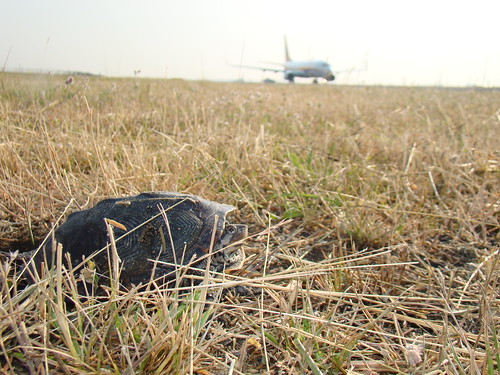
It’s been a busy spring for USDA Wildlife Services’ biologist Jenny Mastantuono and her staff, who work at John F. Kennedy (JFK) International Airport solving wildlife conflicts with people and planes.
One troublesome visitor is the Diamondback terrapin – a type of turtle that prefers to live in brackish marshes. The Jamaica Bay Wildlife Refuge around JFK is a favored habitat for these reptiles. In the late spring, they crawl on to land to lay their eggs in the sandy soils near the airport, often crossing runways to do so. Terrapins on the runway pose a threat to aircraft using the runways. If the terrapins get hit by a plane, their carcass can attract scavengers like gulls which may pose an even greater danger to airline safety.
In addition to the adult terrapin movements in late spring, the previous years’ clutch hatches in the early spring, emerging from their nests and crawling across the runways and taxiways back to the water. These young terrapins can attract predators like herons and gulls—presenting a strike hazard. Any debris or animal on the runway—regardless of size—is a threat to airline passenger safety and a concern for airport operations and Wildlife Services biologists.

While terrapin trouble is a problem unique to JFK, seasonal issues with wildlife are common at any airport. Wildlife Services biologists monitor seasonal wildlife behavior changes like migration patterns so they can predict and resolve conflicts with humans ahead of time, preferably using nonlethal methods. The adult terrapins at JFK temporarily halted air traffic in 2011, and Wildlife Services is watching the runways to prevent any conflicts this year as well.
Jenny and the USDA Wildlife Services staff at JFK scare away wildlife with a number of technical solutions like pyrotechnics and noise making devices that help to prevent airline strikes with wildlife.
“Work at JFK International Airport has provided me with unique experiences and continues to prove to be a fascinating place to work,” says Mastantuono.
Wildlife biologists at JFK have worked to redirect the terrapins in out of harm’s way and more directly to areas that are suitable for nesting.




